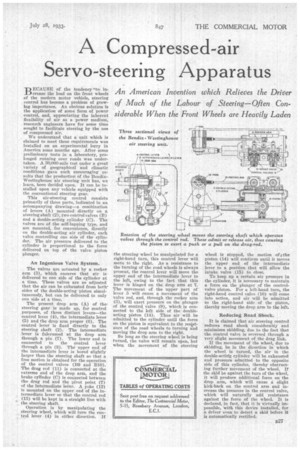A Compressed-air Servo-steering Apparatus
Page 45

If you've noticed an error in this article please click here to report it so we can fix it.
An American Invention which Relieves the Driver of Much of the Labour of Steering—Often Considerable When the Front Wheels are Heavily Laden
BECAUSE of the tendency ,'to increase the load on the front wheels of the modern motor vehicle, steering control has become a problem of growing importance. An obvious solution is the application of some form of power control, and, appreciating the inherent flexibility of air as a power medium, research engineers have for some time sought to facilitate steering by the use of compressed air.
We understand that a unit which is claimed to meet these requirements was installed on an experimental lorry in America some months ago. After some preliminary tests in a laboratory, prolonged running over roads was undertaken. A 30,000-mile test under a great variety of geographical and climatic conditions ,gave such encouraging results that the production of the BendixWestinghouse air steering unit has, we learn, been decided upon. It can be Installed upon any vehicle equipped with the conventional steering gear.
This air-steering control consists primarily of three parts, indicated hi an accompanying drawing—a combination of levers (A) mounted directly on a steering shaft (2), two control valves (B) and a double-acting cylinder (C). The valves are of the self-lapping type, and are mounted, for convenience, directly on the double-acting air cylinder, each valve controlling one side of the cylinder. The air pressure delivered to the cylinder is proportional to the force delivered on top of the valve piston plunger.
An Ingenious Valve System.
The valves are actuated by a rocker arm (3), which ensures that air is delivered to one side of the cylinder at a time. These valves are so adjusted that the air can he exhausted from both' sides of the double-acting piston simultaneously, but can be delivered to only one side at a time.
The present drop arm (A) of the steering gear is made up, for control purposes, of three distinct levers—the control lever (4), the intermediate lever (5) and the drop arm proper (6). The control lever is fixed directly to the steering shaft (2). The intermediate lever is fulcrumed at the drop arm through a pin (7). The lower end is connected to the control lever through a pin (8). The upper end of the intermediate lever is bored slightly larger than the steering shaft so that a free motion is obtained for the operation of the control valves (B9 and B10). The drag rod (11) is connected at the extreme end of the drop arm, and the brake cylinder (C) is connected between the drag rod and the pivot point (7) of the intermediate lever. A yoke (12) is mounted on the upper end of the intermediate lever so that the control rod (13) will be kept in a straight line with the steering shaft.
Operation is by manipulating the steering wheel, which will turn the control lever (4) in either direction. If
the steering wheel be manipulated for a right-hand turn this control lever will move to the HAL As a resistance to the turning of the road wheels is always Present, the control lever will move the upper end of the intermediate lever to the left, owing to the fact that this lever is hinged on the drop arm at T. The movement of the upper part of lever 5 will cause a movement of the valve rod, and, through the rocker arm (3), will exert pressure on the plunger of the control valve (9), which is connected to the left side of the doubleacting piston (14). Thus air will be admitted to the cylinder until the force on the piston is equivalent to the resistance of the road wheels to turning and moving the drop arm to the right.
So long .as the steering wheel is being turned, the valve will remain open, but when the movement of the steering
wheel is stopped, the motion of the piston (14) will continue until it moves the upper end of the intermediate lever to a position that will allow the intake valve (15) to close.
To keep up a certain air pressure in the cylinder, it is necessary to maintain a force on the plunger of the controlvalve piston. For a left-hand turn, the right-hand control valve (10) will come into action, and air will be admitted to the right-hand side of the piston, thereby moving the drop arm to the left.
Reducing Road Shock.
it is claimed that air steering control reduces road shock considerably and minimizes skidding, due to the fact that the control valve is reversed through a very slight movement of the drag link.
If the movement of the wheel, due to skidding, be in the direction in which the wheel is turned, the air in the double-actirfg cylinder will be exhausted and pressure admitted to the opposite side of this cylinder, thereby obstructing further movement of the wheel. If the skid be against the turn of the wheel, it will produce additional force on the drop arm, which will cause a slight kick-back on the control arm and increase the pressure in the control valve, which will naturally add resistance against the force of the wheel. It is declared, in fact, that it is virtually impossible, with this device installed, for a driver even to detect a skid before it is automatically rectified.




































































































